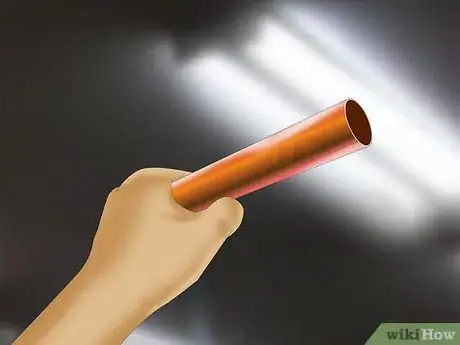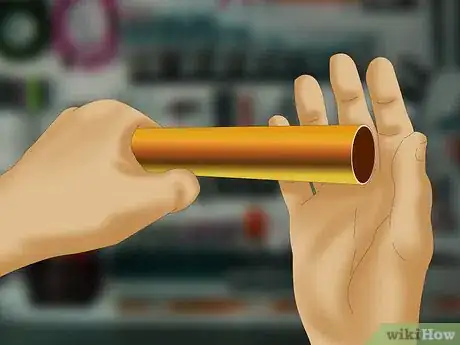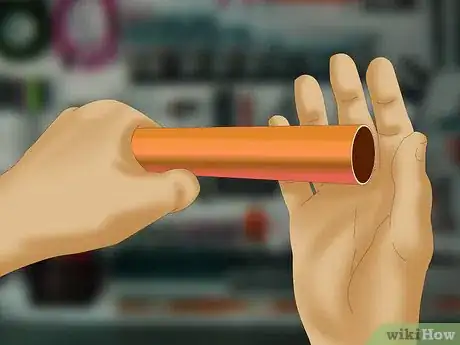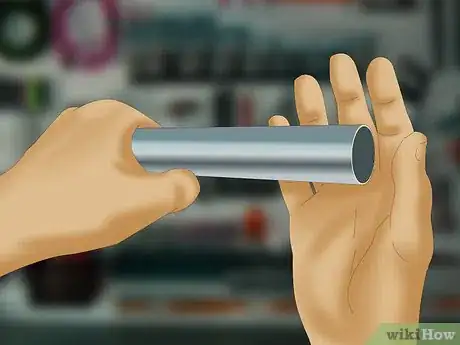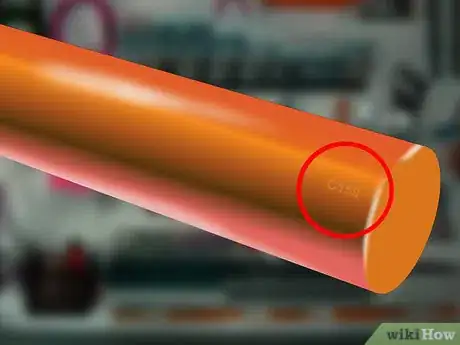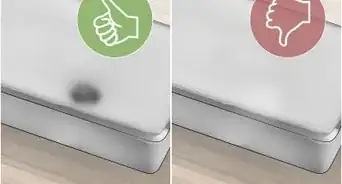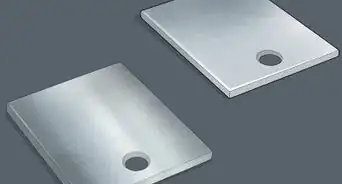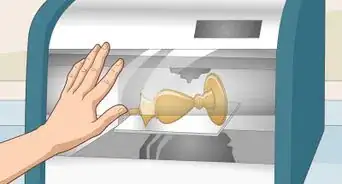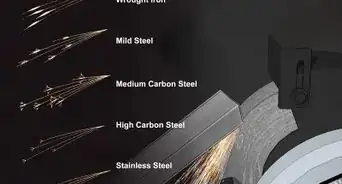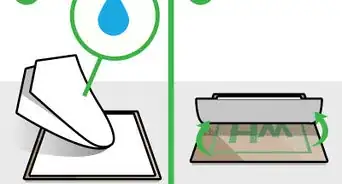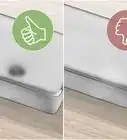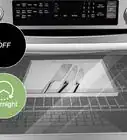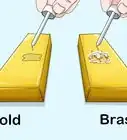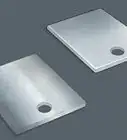This article was co-authored by wikiHow Staff. Our trained team of editors and researchers validate articles for accuracy and comprehensiveness. wikiHow's Content Management Team carefully monitors the work from our editorial staff to ensure that each article is backed by trusted research and meets our high quality standards.
There are 10 references cited in this article, which can be found at the bottom of the page.
This article has been viewed 296,227 times.
Learn more...
Copper is a single metal, so every copper object has roughly the same properties. Brass, on the other hand, is an alloy of copper, zinc, and often other metals as well. The hundreds of different combinations means there is no single, foolproof way to identify all brass. That said, the color of the brass is usually distinct enough to separate it from copper.
Steps
Identifying by Color
-
1Clean the metal if necessary. Both brass and copper develop a patina with age, usually green but sometimes other colors.[1] If none of the original metal is visible, try brass cleaning techniques. These typically work for both metals, but to be safe you could use a commercial brass and copper cleaning product.
-
2Hold the metal under white light. If the metal is highly polished, you may see false colors due to reflected light.[2] Look at it in sunlight or under a white fluorescent light bulb, not under a yellow incandescent bulb.Advertisement
-
3Identify copper's reddish color. Copper is a pure metal, and always has a reddish brown appearance. A modern US penny is plated in copper (and was almost entirely copper from 1962 to 1981), so this is a good point of comparison.
-
4Inspect yellow brass. The word brass refers to any alloy that contains copper and zinc. Different proportions of these metals produce different colors, but the most common types of brass have a muted yellow color, or a yellow-brown appearance similar to bronze. These brass alloys are widely used in machined parts and screws.
- Some brass has a greenish-yellow appearance, but this alloy, called "gilding metal," is only used for a few specialized purposes in decoration and ammunition.[3]
-
5Learn about red or orange brass. Many other common brass alloys can look orange or reddish brown, when they contain at least 85% copper.[4] These types of brass are usually found in jewelry, decorative fasteners, or plumbing. Any hint of orange, yellow, or gold means the item is brass, not copper. If the brass alloy is almost entirely copper, you may need to compare it side by side with a copper pipe or item of jewelry. If you're still not sure, it's either copper or brass with such a high copper content that the distinction may not be important.
-
6
Other Identification Methods
-
1Strike the metal and listen to the sound. Since copper is quite soft, it should produce a muted, round sound.[7] A test way back in 1867 described copper's sound as "dead," while brass emitted a "clear ringing note."[8] This might be tough to judge without experience, but learning it could prove useful for an antiquing or scrap collection hobby.
- This works best for thick, solid metal objects.
-
2Look for stamped codes. Brass objects made for industrial purposes often have a code stamped on them to identify the exact alloy. In both the North American and European systems, the codes for brass begin with a C and are followed by several numbers. Copper is often left unlabeled, but if you want to be sure, double check the code with this quick guide:
- The UNS system in North America uses brass labels beginning with C2, C3, or C4, or fall between C83300 and C89999. Copper, if labeled, can use codes from C10100 to C15999, and C80000–C81399.[9] The last two digits are often dropped.
- In the current European system, both copper and brass begin with C. Brass ends with the letter L, M, N, P, or R, while copper ends with A, B, C, or D.[10]
- Older brass may not conform to these systems. Some older European standards (which were used quite recently) list the element symbols followed by a percentage. Anything that contains "Cu" and "Zn" is considered brass.
-
3Check how hard the metal is. This test is usually not too helpful, since brass is only slightly harder than copper.[11] Some types of treated copper are particularly soft, so you may be able to scratch them with a US penny (which is never true of brass).[12] However, in many cases there is no convenient object that will scratch one object but not the other.
- Copper is easier to bend than brass as well, but it's difficult to draw exact conclusions from that test (especially without damaging the object).
Community Q&A
-
QuestionThe item is tarnished so the color test does not help. Any other pointers?
 Community AnswerTry the sound test against two different materials. Copper will not make much of a sound, but brass will ring loud and clear. Sound is probably the most foolproof way to test the difference between copper and other metals.
Community AnswerTry the sound test against two different materials. Copper will not make much of a sound, but brass will ring loud and clear. Sound is probably the most foolproof way to test the difference between copper and other metals. -
QuestionI have an apple butter kettle and would like to find out if this piece is brass or copper. Is there a test that I can perform that would let me know one way or the other?
 Community AnswerLightly strike it with the convex side of a tablespoon's heel. If it "thunks" more than it rings, it is copper; if it rings, it's brass.
Community AnswerLightly strike it with the convex side of a tablespoon's heel. If it "thunks" more than it rings, it is copper; if it rings, it's brass. -
QuestionHow do I tell the difference between copper and zinc?
 Community AnswerZinc is a white or silvery metal, while copper is red. If you're trying to separate pure copper coins and zinc-plated copper coins, weigh them on a gram scale. You can find the expected weights of coins online or in coin collector handbooks.
Community AnswerZinc is a white or silvery metal, while copper is red. If you're trying to separate pure copper coins and zinc-plated copper coins, weigh them on a gram scale. You can find the expected weights of coins online or in coin collector handbooks.
References
- ↑ http://www.minerals.net/mineral/copper.aspx
- ↑ https://play.google.com/store/books/details?id=_BtbAAAAYAAJ
- ↑ https://play.google.com/store/books/details?id=_BtbAAAAYAAJ
- ↑ https://play.google.com/store/books/details?id=_BtbAAAAYAAJ
- ↑ https://play.google.com/store/books/details?id=_BtbAAAAYAAJ
- ↑ http://www.britannica.com/technology/brass-alloy#ref167378
- ↑ https://www.highettmetal.com.au/blog/copper/how-to-tell-the-difference-between-copper-and-brass
- ↑ https://play.google.com/store/books/details?id=0_ZEAQAAMAAJ&rdid=book-0_ZEAQAAMAAJ
- ↑ http://unscopperalloys.org/
About This Article
To tell brass from copper, hold the metal under sunlight or a white fluorescent light bulb to check the color. If the metal is copper, it will have a reddish brown hue, similar to that of a penny. On the other hand, brass will have a yellow-brown appearance, similar to bronze. Alternatively, strike the metal against a hard surface and listen to the sound. Copper will have a soft, muted sound, whereas brass will emit a clear, ringing tone. For more advice, including how to tell brass from copper by checking for stamped codes, keep reading.

